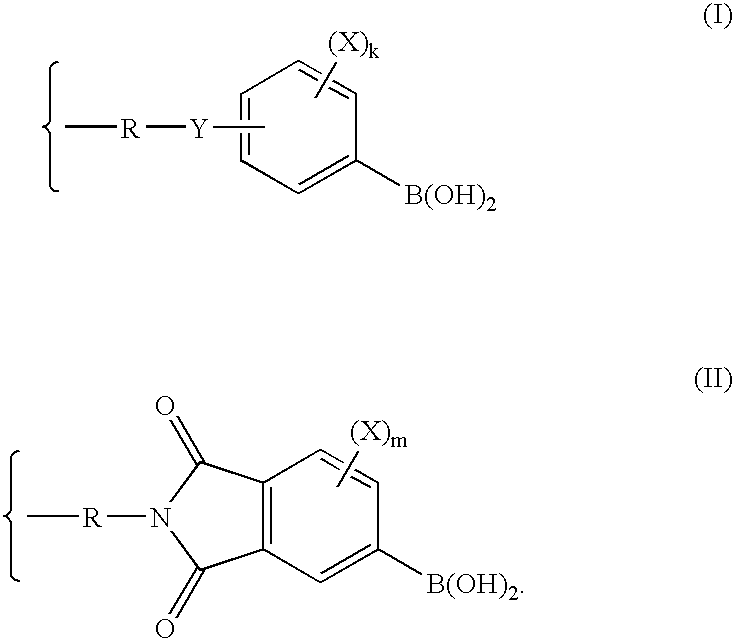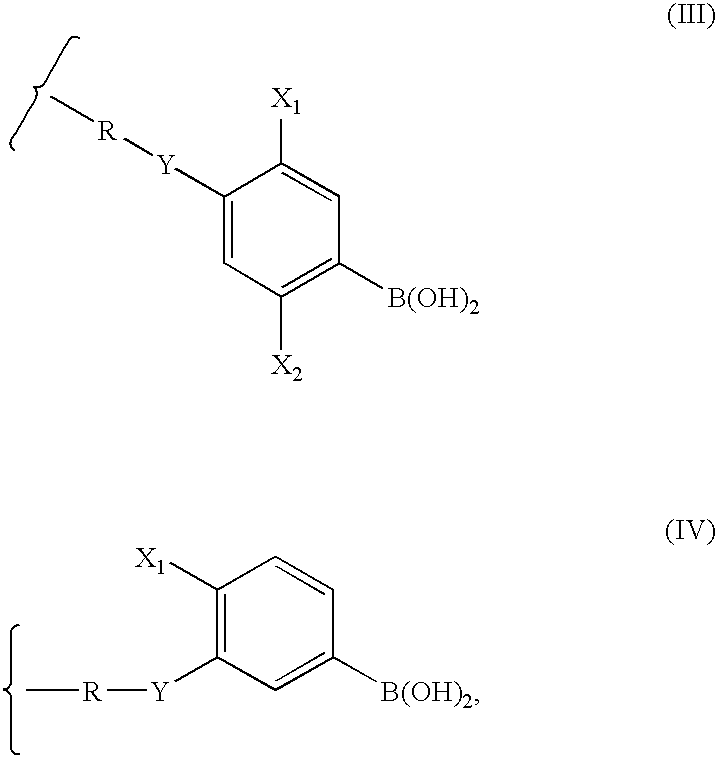Polymeric boronic acid derivatives as lipase inhibitors
- Summary
- Abstract
- Description
- Claims
- Application Information
AI Technical Summary
Benefits of technology
Problems solved by technology
Method used
Image
Examples
example 1
4-(13′-acryloxy-2′-thia)tridecyl phenyl boronic acid
[0084] To a 250-mil, three-necked, round bottomed flask were added 10 g of 4-bromomethylphenyl boronic acid and 100 ml of tetrahydrofuran (THF); After complete dissolution, the solution was degassed by bubbling nitrogen through the reaction mixture for about 30 minutes. While stirring, 9.51 g of 11-mercaptoundecanol was added to this solution under nitrogen. Diisopropylethylamine (23.4 mL) was added via a syringe over 5 minutes. The reaction mixture was kept stirring for 48 hours under nitrogen at room temperature. TLC showed the reaction was complete. The solvent was removed in vacuo, and the residue was partitioned between ethyl acetate (300 mL) and water (150 mL). The organic phase was washed with water (100 mL), 5% hydrochloric acid solution (3×100 mL), water (100 mL), and brine (100 mL). The ethyl acetate solution was dried over sodium sulfate for 30 minutes. After filtration, the solvent was removed in vacuo. The residue was...
example 2
4-(14′-Acryloxy-3′-thia-1′-keto)tetradecyl Phenyl boronic Acid
[0086] To a 2-liter, three-necked, round bottomed flask fitted with an overhead stirrer were added 100 g of 4-(14′-hydroxy-3′-thia-1′-keto)tetradecyl phenyl boronic acid (the synthesis is described in U.S. Application Nos. 60 / 302,081 and 10 / 187,397, published as US 2003 / 0064963 A1)) and 400 ml of anhydrous tetrahydrofuran (THF) and 57.5 ml of diisopropylethylamine. While stirring the reaction was cooled to 0° C. under nitrogen atmosphere and 29.7 g of acryloyl chloride was added slowly. The reaction mixture was allowed to warm to room temperature slowly and stirring continued for 4 hr at room temperature. Another batch of diisopropylethylamine (11.1 ml) and stirring continued at room temperature. After 24 hr, 11.1 ml of disopropylethylamine and 11.1 ml of acryloyl chloride were added successively to the reaction mixture. Stirring continued for further 24 hr and another batch of acryloyl chloride (7.4 ml) was added. This ...
example 3
4-(14′-methacryloxy-3′-thia-1′-keto)tetradecyl phenyl boronic acid
[0087] To a 500 ml, three-necked, round bottomed flask were added 10.29 g of 4-(14′-hydroxy-3′-thia-1′-keto)tetradecyl phenyl boronic acid (the synthesis is described in U.S. Ser. No. 60 / 302,081), 90 ml of dichloromethane, 20 ml of DMF and 4.9 ml of diisopropylethylamine. The reaction mixture was allowed to cool down to 0° C. using an ice bath. While stirring under nitrogen atmosphere, 4.0 ml of methacryloyl chloride dissolved in 10 ml of dichloromethane was added to the reaction mixture over a period of 25 minutes while maintaining temperature to below 5° C. throughout the course of addition. After 1 hr, additional 4.9 ml of diisopropylethylamine was added. The reaction mixture was allowed to warm up to room temperature slowly and was stirred at room temperature for 16 hr. Methacryloyl chloride (3.0 ml) followed by diisopropylethylamine (3.0 ml) were added and stirring continued for additional 24 hr. The reaction mi...
PUM
| Property | Measurement | Unit |
|---|---|---|
| Mass | aaaaa | aaaaa |
| Mass | aaaaa | aaaaa |
| Dimensionless property | aaaaa | aaaaa |
Abstract
Description
Claims
Application Information
 Login to View More
Login to View More - R&D
- Intellectual Property
- Life Sciences
- Materials
- Tech Scout
- Unparalleled Data Quality
- Higher Quality Content
- 60% Fewer Hallucinations
Browse by: Latest US Patents, China's latest patents, Technical Efficacy Thesaurus, Application Domain, Technology Topic, Popular Technical Reports.
© 2025 PatSnap. All rights reserved.Legal|Privacy policy|Modern Slavery Act Transparency Statement|Sitemap|About US| Contact US: help@patsnap.com



